towing JEEP COMPASS 2012 1.G User Guide
[x] Cancel search | Manufacturer: JEEP, Model Year: 2012, Model line: COMPASS, Model: JEEP COMPASS 2012 1.GPages: 108, PDF Size: 4.03 MB
Page 2 of 108
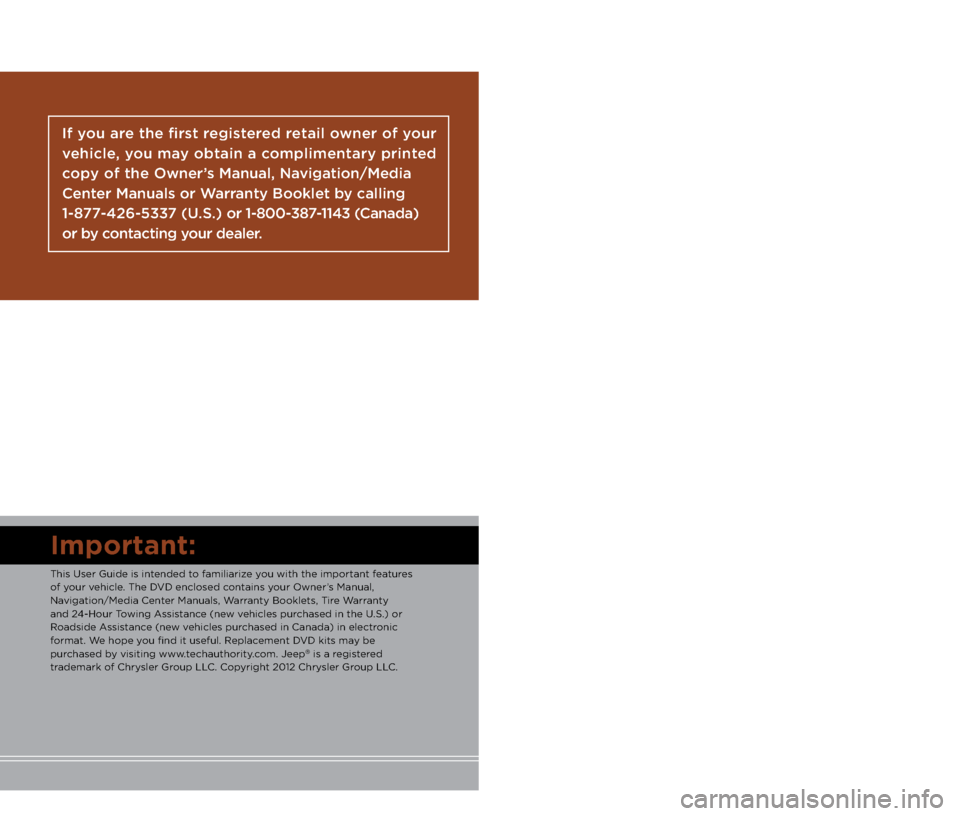
I\fportant:
This User Guide is i\.ntended to familiarize you with the important\. features
of your vehi\fle. The DVD en\flosed \fontains your \bwner’s Manual,
Navigation/Media Center Manuals, Warranty Booklets, Tire Warranty
and 24-Hour Towing Assistan\fe (new vehi\fles pur\fhased in the U.S.) or
Roadside Assistan\fe (new vehi\fles pur\fhased in Canada) i\.n ele\ftroni\f
format. We hope you find it useful. R\.epla\fement DVD kits may be
pur\fhased by visiting www.te\fhauthority.\fom. Jeep
® is a registered
trademark of Chrysler Group LLC. Copyright 2012 Chrysler Group LLC.
If you are the first registered retail owner of your
\fehicle, you may o\btain a complimentary printed
copy of the Owner’s Manual, Na\figation/Media
Center Manuals or Warranty Booklet \by calling
1-877-426-5337 (U.S.) or 1-800-387-1143 (Canada)
or \by contacting your dealer.
The driver’s primary responsibility
is the safe operation of the
vehi\fle. Driving while dis\.tra\fted
\fan result in loss of vehi\fle
\fontrol, resulting in a \follision and
personal injury. Chrysler Group
LLC strongly re\fommends that
the driver use extreme \faution
when using any devi\fe or feature
that may take their attention off
the road. Use of any ele\ftri\fal
devi\fes su\fh as \fell phones,
\fomputers, portable radios,
vehi\fle navigation or other
devi\fes by the driver while the vehi\fle is moving is dangerous
and \fould lead to a serious
\follision. Texting while driving\. is
also dangerous and should never
be done while the vehi\fle is
moving. If you find yourself
unable to devote your full
attention to vehi\fle operation,
pull off the road to a safe lo\fation
and stop your vehi\fle. Some
States or Provin\fes prohibit the
use of \fellular telephones or
texting while driving\.. It is always
the driver’s responsibility to
\fomply with all lo\fal\. laws.
WAR\bI\bG!
Driving after drinking \fan lea\.d to a \follision. Your per\feptions are
less sharp, your reflexes are slower, and your judgment is imp\.aired
when you have been drinking. Ne\.ver drink and then d\.rive.
Driving and Alcohol:
Drunken driving is one \.of the most frequent \fauses of \follisions. Your
driving ability \fan\. be seriously impa\.ired with blood al\fohol levels far below
the legal minimum. I\.f you are drinking, don’t d\.rive. Ride with a design\.ated
non-drinking driver, \fall a \fab, a friend, or use\. publi\f transportation.
This guide has been \.prepared to help you get qui\fkly
a\fquainted with your new Jeep and to provide a \fonvenient
referen\fe sour\fe for \fommon questions. However, it is not a
substitute for your \bwner’s Manual.
For \fomplete operational instru\ftions, maintenan\fe pro\fedures
and important safety messages, please \fonsult your \bwner’s
Manual, Navigation/Media Center Manuals and othe\.r Warning
Labels in your vehi\fle.
Not all features shown in this guide ma\.y apply to your vehi\fle.
For additional information on a\f\fessories to help personalize
your vehi\fle, visit www.mopar.\fom or your lo\fal Jeep deal\.er.
919046_12c_Compass_User_Guide_012512.indd 21/25/12 3:43 PM
Page 3 of 108
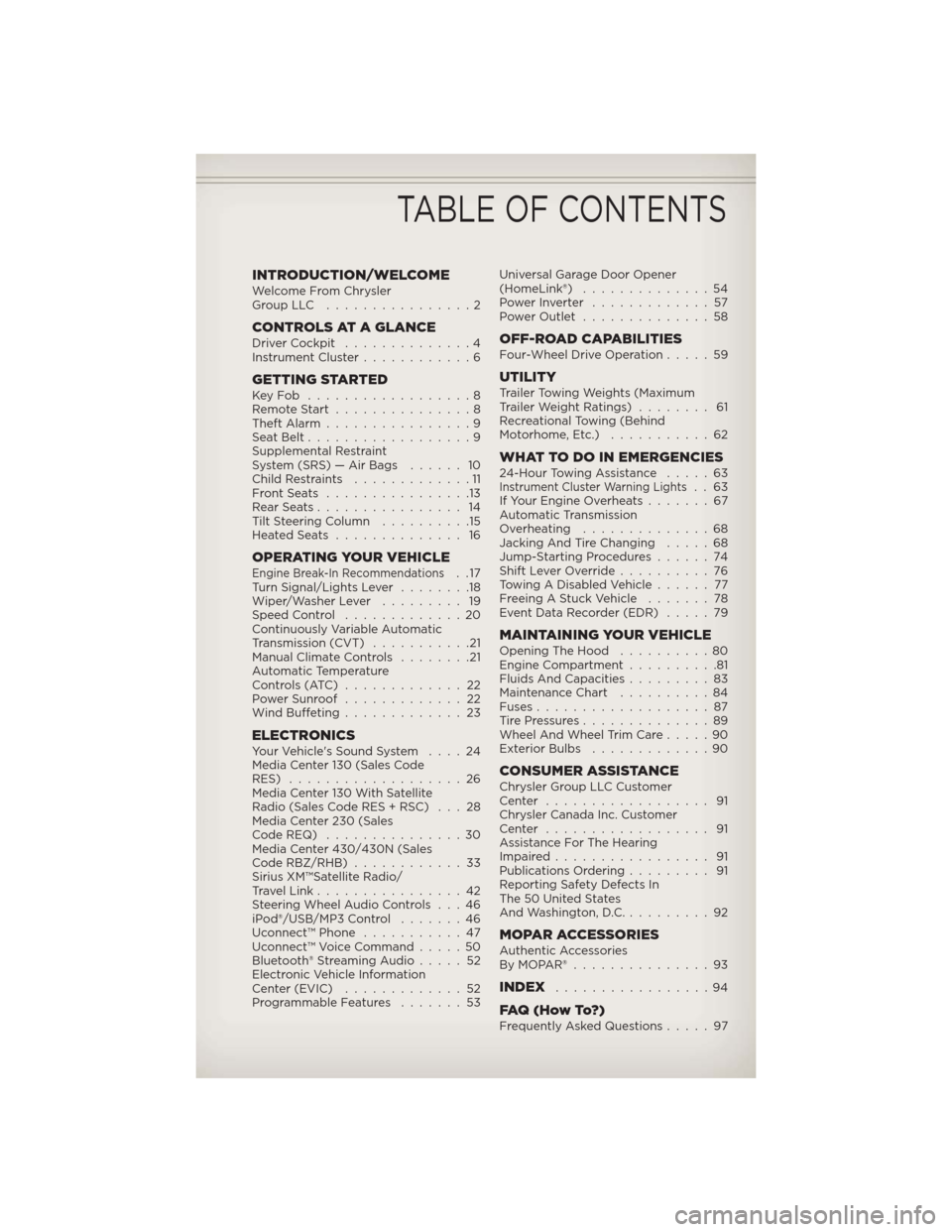
INTRODUCTION/WELCOMEWelcome From Chrysler
GroupLLC ................2
CONTROLS AT A GLANCEDriver Cockpit..............4
Instrument Cluster............6
GETTING STARTEDKeyFob ..................8
Remote Start...............8
Theft Alarm................9
Seat Belt..................9
Supplemental Restraint
System (SRS) — Air Bags...... 10
Child Restraints.............11
FrontSeats ................13
RearSeats................ 14
Tilt Steering Column..........15
HeatedSeats .............. 16
OPERATING YOUR VEHICLEEngine Break-In Recommendations..17
Turn Signal/Lights Lever........18
Wiper/Washer Lever......... 19
Speed Control.............20
Continuously Variable Automatic
Transmission (CVT)...........21
Manual Climate Controls........21
Automatic Temperature
Controls (ATC).............22
Power Sunroof.............22
Wind Buffeting.............23
ELECTRONICSYour Vehicle's Sound System....24
Media Center 130 (Sales Code
RES)...................26
Media Center 130 With Satellite
Radio (Sales Code RES + RSC) . . . 28
Media Center 230 (Sales
CodeREQ) ...............30
Media Center 430/430N (Sales
Code RBZ/RHB)............33
Sirius XM™Satellite Radio/
Travel Link................42
Steering Wheel Audio Controls . . . 46
iPod®/USB/MP3 Control.......46
Uconnect™ Phone...........47
Uconnect™ Voice Command.....50
Bluetooth® Streaming Audio.....52
Electronic Vehicle Information
Center (EVIC).............52
Programmable Features.......53Universal Garage Door Opener
(HomeLink®)..............54
PowerInverter .............57
Power Outlet..............58
OFF-ROAD CAPABILITIESFour-Wheel Drive Operation.....59
UTILITYTrailer Towing Weights (Maximum
Trailer Weight Ratings)........ 61
Recreational Towing (Behind
Motorhome, Etc.)...........62
WHAT TO DO IN EMERGENCIES24-Hour Towing Assistance.....63Instrument Cluster Warning Lights..63
If Your Engine Overheats.......67
Automatic Transmission
Overheating..............68
Jacking And Tire Changing.....68
Jump-Starting Procedures......74
Shift Lever Override..........76
Towing A Disabled Vehicle...... 77
Freeing A Stuck Vehicle.......78
Event Data Recorder (EDR).....79
MAINTAINING YOUR VEHICLEOpening The Hood..........80
Engine Compartment..........81
Fluids And Capacities.........83
Maintenance Chart..........84
Fuses...................87
TirePressures..............89
Wheel And Wheel Trim Care.....90
Exterior Bulbs.............90
CONSUMER ASSISTANCEChrysler Group LLC Customer
Center .................. 91
Chrysler Canada Inc. Customer
Center .................. 91
Assistance For The Hearing
Impaired................. 91
Publications Ordering......... 91
Reporting Safety Defects In
The 50 United States
And Washington, D.C..........92
MOPAR ACCESSORIESAuthentic Accessories
ByMOPAR®...............93
INDEX.................94
FAQ(HowTo?)Frequently Asked Questions.....97
TABLE OF CONTENTS
Page 63 of 108
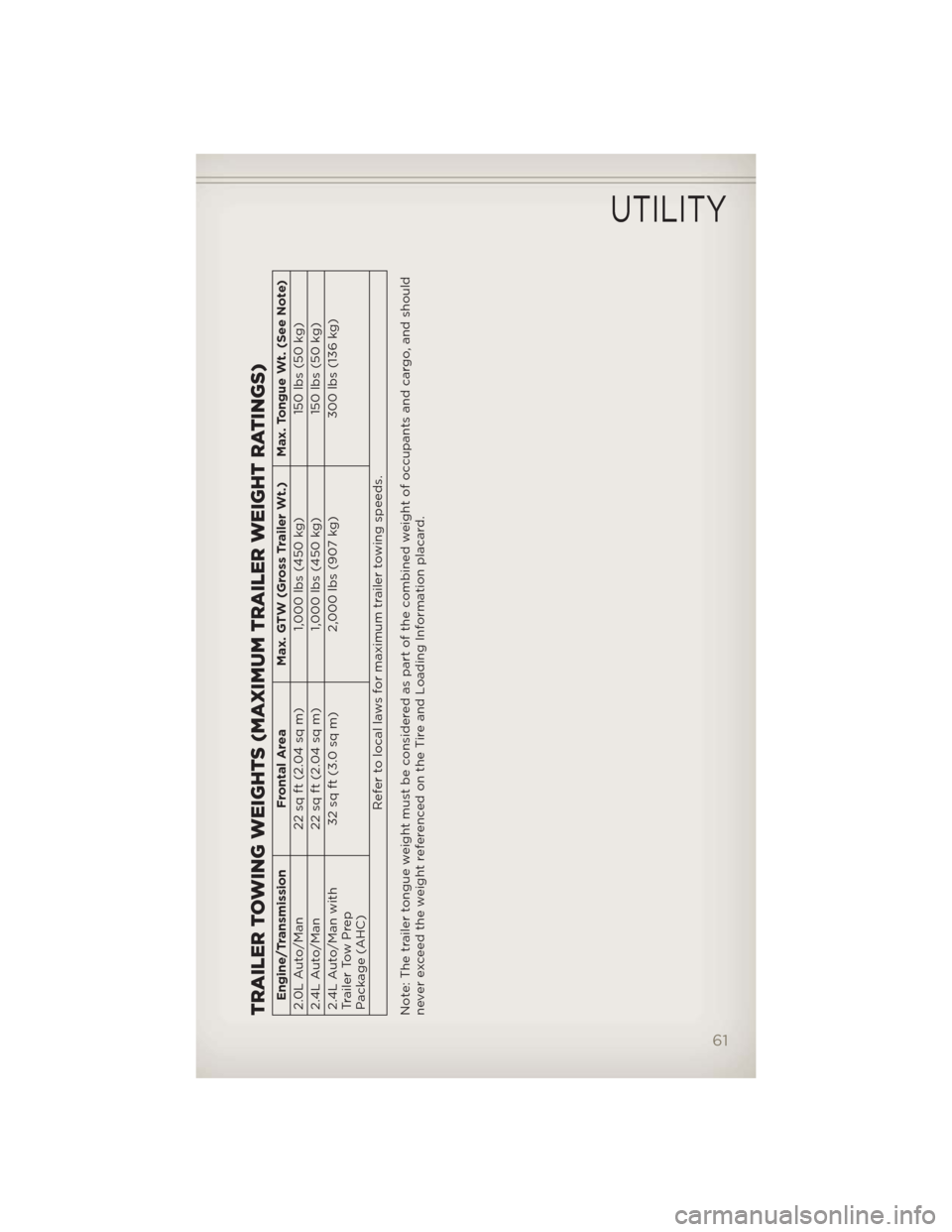
TRAILER TOWING WEIGHTS (MAXIMUM TRAILER WEIGHT RATINGS)Engine/Transmission Frontal Area Max. GTW (Gross Trailer Wt.) Max. Tongue Wt. (See Note)
2.0L Auto/Man 22 sq ft (2.04 sq m) 1,000 lbs (450 kg) 150 lbs (50 kg)
2.4L Auto/Man 22 sq ft (2.04 sq m) 1,000 lbs (450 kg) 150 lbs (50 kg)
2.4L Auto/Man with
Trailer Tow Prep
Package (AHC)32 sq ft (3.0 sq m) 2,000 lbs (907 kg) 300 lbs (136 kg)
Refer to local laws for maximum trailer towing speeds.
Note: The trailer tongue weight must be considered as part of the combined weight of occupants and cargo, and should
never exceed the weight referenced on the Tire and Loading Information placard.
UTILITY
61
Page 64 of 108
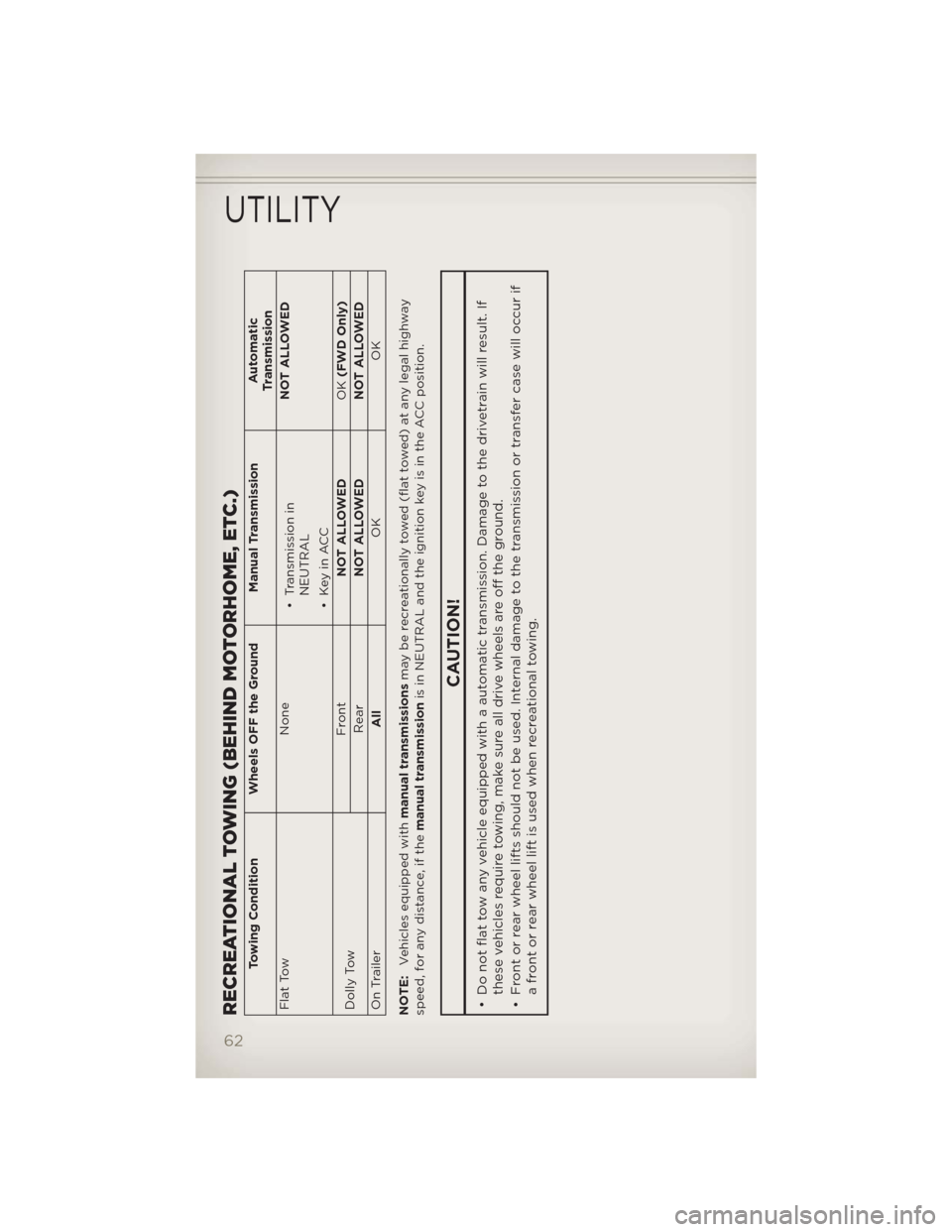
RECREATIONAL TOWING (BEHIND MOTORHOME, ETC.)
Towing Condition Wheels OFF the Ground Manual TransmissionAutomatic
Transmission
Flat Tow None
• Transmission in
NEUTRAL
• Key in ACCNOT ALLOWED
Dolly TowFront
NOT ALLOWEDOK(FWD Only)
Rear
NOT ALLOWED NOT ALLOWED
On Trailer
AllOK OK
NOTE:Vehicles equipped withmanual transmissionsmay be recreationally towed (flat towed) at any legal highway
speed, for any distance, if themanual transmissionis in NEUTRAL and the ignition key is in the ACC position.
CAUTION!
• Do not flat tow any vehicle equipped with a automatic transmission. Damage to the drivetrain will result. If
these vehicles require towing, make sure all drive wheels are off the ground.
• Front or rear wheel lifts should not be used. Internal damage to the transmission or transfer case will occur if
a front or rear wheel lift is used when recreational towing.
UTILITY
62
Page 65 of 108
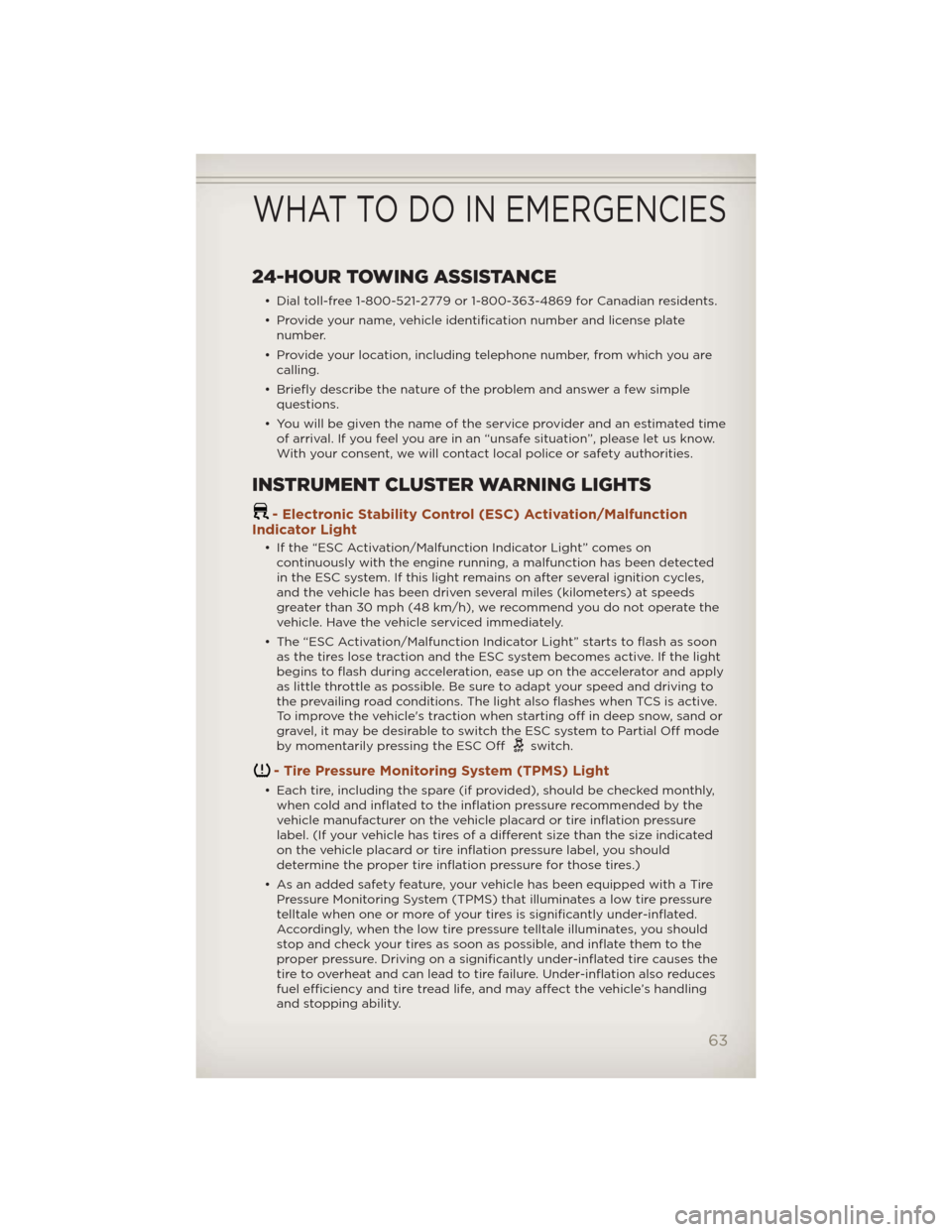
24-HOUR TOWING ASSISTANCE
• Dial toll-free 1-800-521-2779 or 1-800-363-4869 for Canadian residents.
• Provide your name, vehicle identification number and license plate
number.
• Provide your location, including telephone number, from which you are
calling.
• Briefly describe the nature of the problem and answer a few simple
questions.
• You will be given the name of the service provider and an estimated time
of arrival. If you feel you are in an “unsafe situation”, please let us know.
With your consent, we will contact local police or safety authorities.
INSTRUMENT CLUSTER WARNING LIGHTS
- Electronic Stability Control (ESC) Activation/Malfunction
Indicator Light
• If the “ESC Activation/Malfunction Indicator Light” comes on
continuously with the engine running, a malfunction has been detected
in the ESC system. If this light remains on after several ignition cycles,
and the vehicle has been driven several miles (kilometers) at speeds
greater than 30 mph (48 km/h), we recommend you do not operate the
vehicle. Have the vehicle serviced immediately.
• The “ESC Activation/Malfunction Indicator Light” starts to flash as soon
as the tires lose traction and the ESC system becomes active. If the light
begins to flash during acceleration, ease up on the accelerator and apply
as little throttle as possible. Be sure to adapt your speed and driving to
the prevailing road conditions. The light also flashes when TCS is active.
To improve the vehicle's traction when starting off in deep snow, sand or
gravel, it may be desirable to switch the ESC system to Partial Off mode
by momentarily pressing the ESC Off
switch.
- Tire Pressure Monitoring System (TPMS) Light
• Each tire, including the spare (if provided), should be checked monthly,
when cold and inflated to the inflation pressure recommended by the
vehicle manufacturer on the vehicle placard or tire inflation pressure
label. (If your vehicle has tires of a different size than the size indicated
on the vehicle placard or tire inflation pressure label, you should
determine the proper tire inflation pressure for those tires.)
• As an added safety feature, your vehicle has been equipped with a Tire
Pressure Monitoring System (TPMS) that illuminates a low tire pressure
telltale when one or more of your tires is significantly under-inflated.
Accordingly, when the low tire pressure telltale illuminates, you should
stop and check your tires as soon as possible, and inflate them to the
proper pressure. Driving on a significantly under-inflated tire causes the
tire to overheat and can lead to tire failure. Under-inflation also reduces
fuel efficiency and tire tread life, and may affect the vehicle’s handling
and stopping ability.
WHAT TO DO IN EMERGENCIES
63
Page 67 of 108
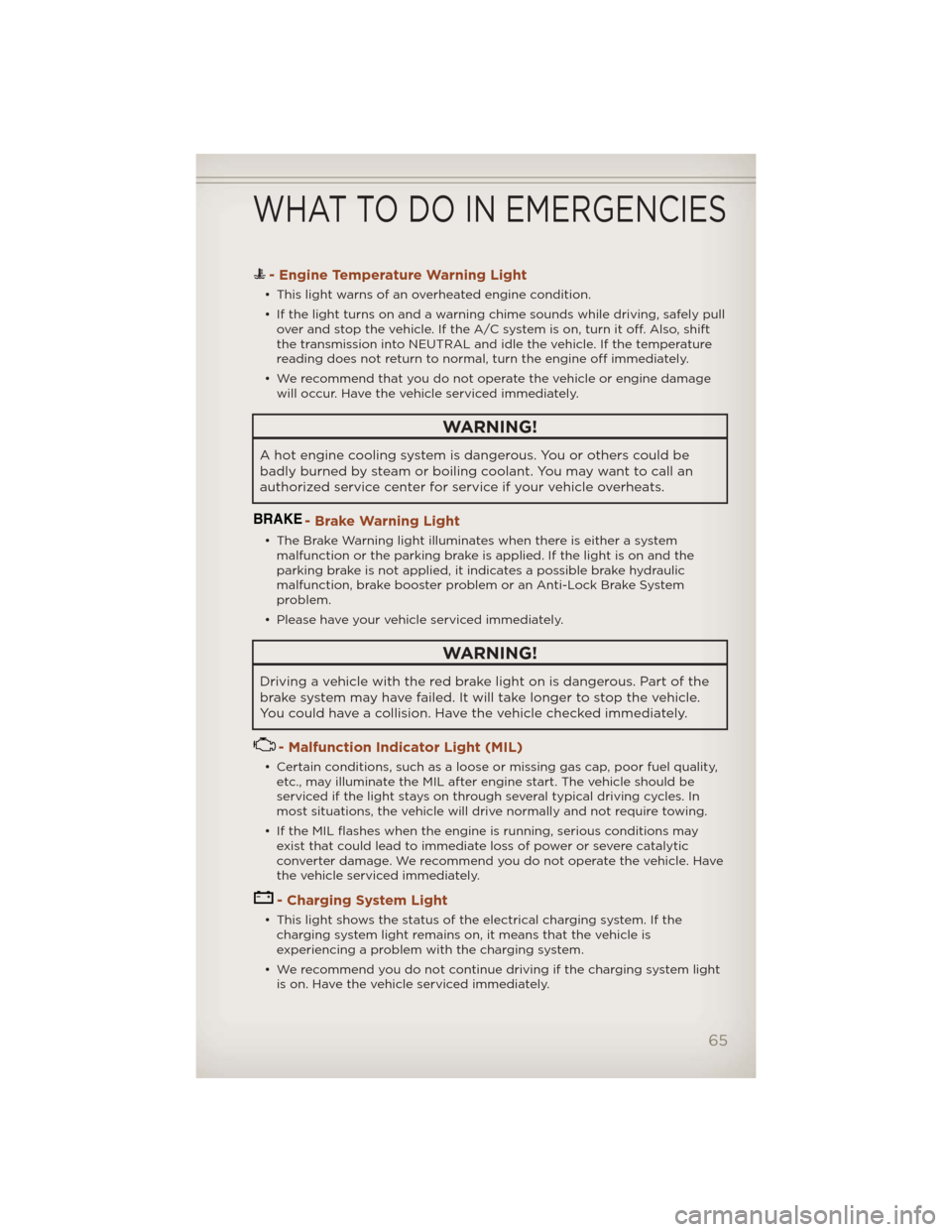
- Engine Temperature Warning Light
• This light warns of an overheated engine condition.
• If the light turns on and a warning chime sounds while driving, safely pull
over and stop the vehicle. If the A/C system is on, turn it off. Also, shift
the transmission into NEUTRAL and idle the vehicle. If the temperature
reading does not return to normal, turn the engine off immediately.
• We recommend that you do not operate the vehicle or engine damage
will occur. Have the vehicle serviced immediately.
WARNING!
A hot engine cooling system is dangerous. You or others could be
badly burned by steam or boiling coolant. You may want to call an
authorized service center for service if your vehicle overheats.
BRAKE- Brake Warning Light
• The Brake Warning light illuminates when there is either a system
malfunction or the parking brake is applied. If the light is on and the
parking brake is not applied, it indicates a possible brake hydraulic
malfunction, brake booster problem or an Anti-Lock Brake System
problem.
• Please have your vehicle serviced immediately.
WARNING!
Driving a vehicle with the red brake light on is dangerous. Part of the
brake system may have failed. It will take longer to stop the vehicle.
You could have a collision. Have the vehicle checked immediately.
- Malfunction Indicator Light (MIL)
• Certain conditions, such as a loose or missing gas cap, poor fuel quality,
etc., may illuminate the MIL after engine start. The vehicle should be
serviced if the light stays on through several typical driving cycles. In
most situations, the vehicle will drive normally and not require towing.
• If the MIL flashes when the engine is running, serious conditions may
exist that could lead to immediate loss of power or severe catalytic
converter damage. We recommend you do not operate the vehicle. Have
the vehicle serviced immediately.
- Charging System Light
• This light shows the status of the electrical charging system. If the
charging system light remains on, it means that the vehicle is
experiencing a problem with the charging system.
• We recommend you do not continue driving if the charging system light
is on. Have the vehicle serviced immediately.
WHAT TO DO IN EMERGENCIES
65
Page 68 of 108
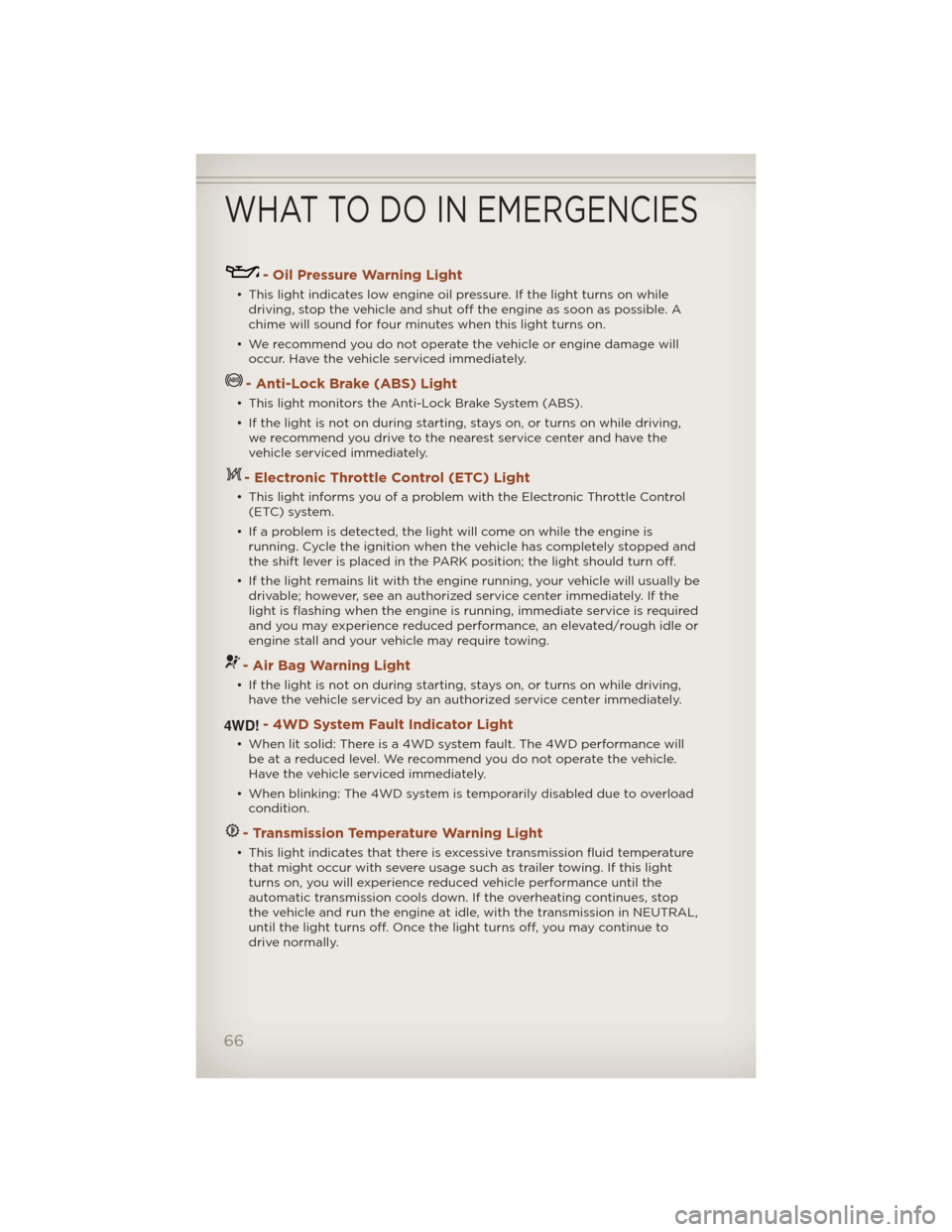
- Oil Pressure Warning Light
• This light indicates low engine oil pressure. If the light turns on while
driving, stop the vehicle and shut off the engine as soon as possible. A
chime will sound for four minutes when this light turns on.
• We recommend you do not operate the vehicle or engine damage will
occur. Have the vehicle serviced immediately.
- Anti-Lock Brake (ABS) Light
• This light monitors the Anti-Lock Brake System (ABS).
• If the light is not on during starting, stays on, or turns on while driving,
we recommend you drive to the nearest service center and have the
vehicle serviced immediately.
- Electronic Throttle Control (ETC) Light
• This light informs you of a problem with the Electronic Throttle Control
(ETC) system.
• If a problem is detected, the light will come on while the engine is
running. Cycle the ignition when the vehicle has completely stopped and
the shift lever is placed in the PARK position; the light should turn off.
• If the light remains lit with the engine running, your vehicle will usually be
drivable; however, see an authorized service center immediately. If the
light is flashing when the engine is running, immediate service is required
and you may experience reduced performance, an elevated/rough idle or
engine stall and your vehicle may require towing.
- Air Bag Warning Light
• If the light is not on during starting, stays on, or turns on while driving,
have the vehicle serviced by an authorized service center immediately.
4WD!- 4WD System Fault Indicator Light
• When lit solid: There is a 4WD system fault. The 4WD performance will
be at a reduced level. We recommend you do not operate the vehicle.
Have the vehicle serviced immediately.
• When blinking: The 4WD system is temporarily disabled due to overload
condition.
- Transmission Temperature Warning Light
• This light indicates that there is excessive transmission fluid temperature
that might occur with severe usage such as trailer towing. If this light
turns on, you will experience reduced vehicle performance until the
automatic transmission cools down. If the overheating continues, stop
the vehicle and run the engine at idle, with the transmission in NEUTRAL,
until the light turns off. Once the light turns off, you may continue to
drive normally.
WHAT TO DO IN EMERGENCIES
66
Page 70 of 108
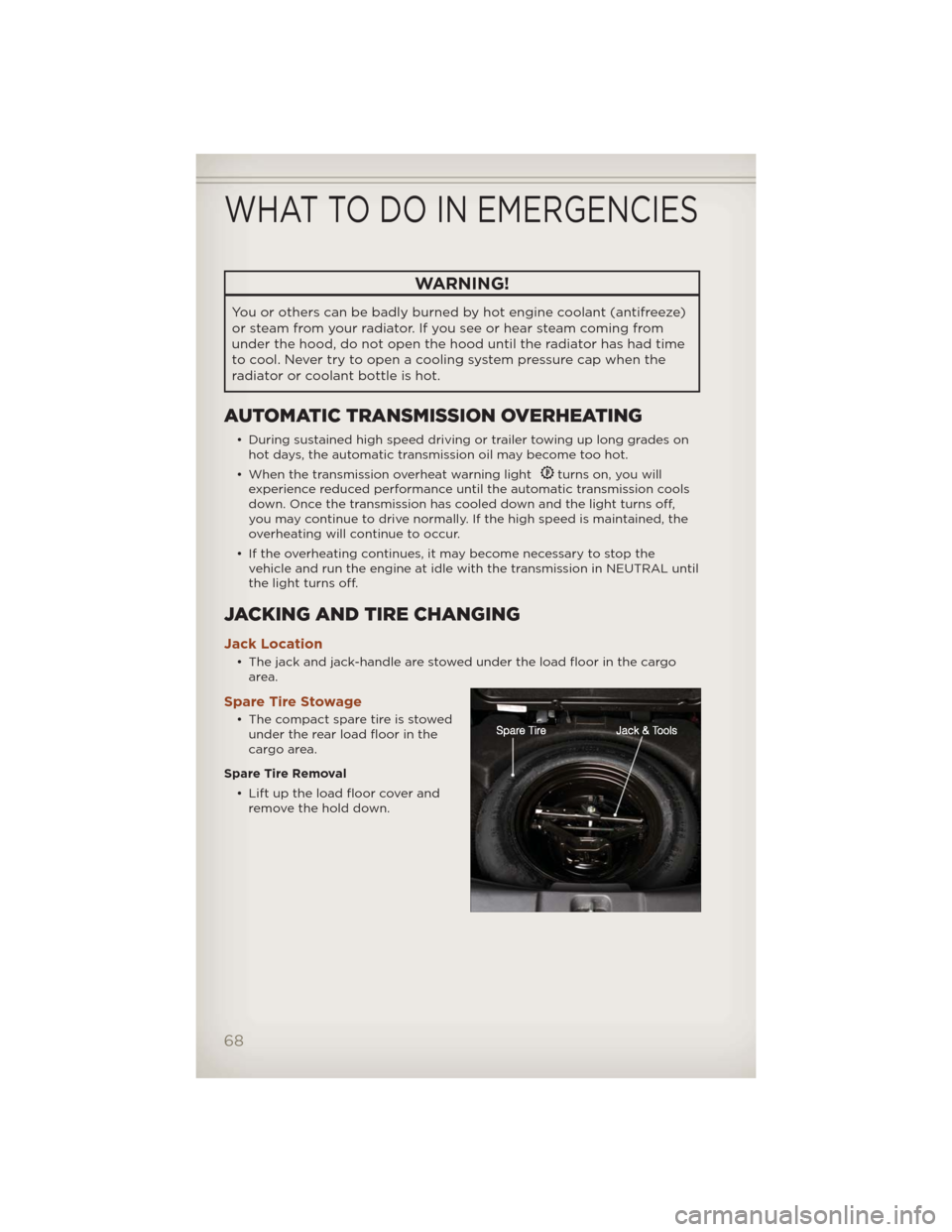
WARNING!
You or others can be badly burned by hot engine coolant (antifreeze)
or steam from your radiator. If you see or hear steam coming from
under the hood, do not open the hood until the radiator has had time
to cool. Never try to open a cooling system pressure cap when the
radiator or coolant bottle is hot.
AUTOMATIC TRANSMISSION OVERHEATING
• During sustained high speed driving or trailer towing up long grades on
hot days, the automatic transmission oil may become too hot.
• When the transmission overheat warning light
turns on, you will
experience reduced performance until the automatic transmission cools
down. Once the transmission has cooled down and the light turns off,
you may continue to drive normally. If the high speed is maintained, the
overheating will continue to occur.
• If the overheating continues, it may become necessary to stop the
vehicle and run the engine at idle with the transmission in NEUTRAL until
the light turns off.
JACKING AND TIRE CHANGING
Jack Location
• The jack and jack-handle are stowed under the load floor in the cargo
area.
Spare Tire Stowage
• The compact spare tire is stowed
under the rear load floor in the
cargo area.
Spare Tire Removal
• Lift up the load floor cover and
remove the hold down.
WHAT TO DO IN EMERGENCIES
68
Page 79 of 108
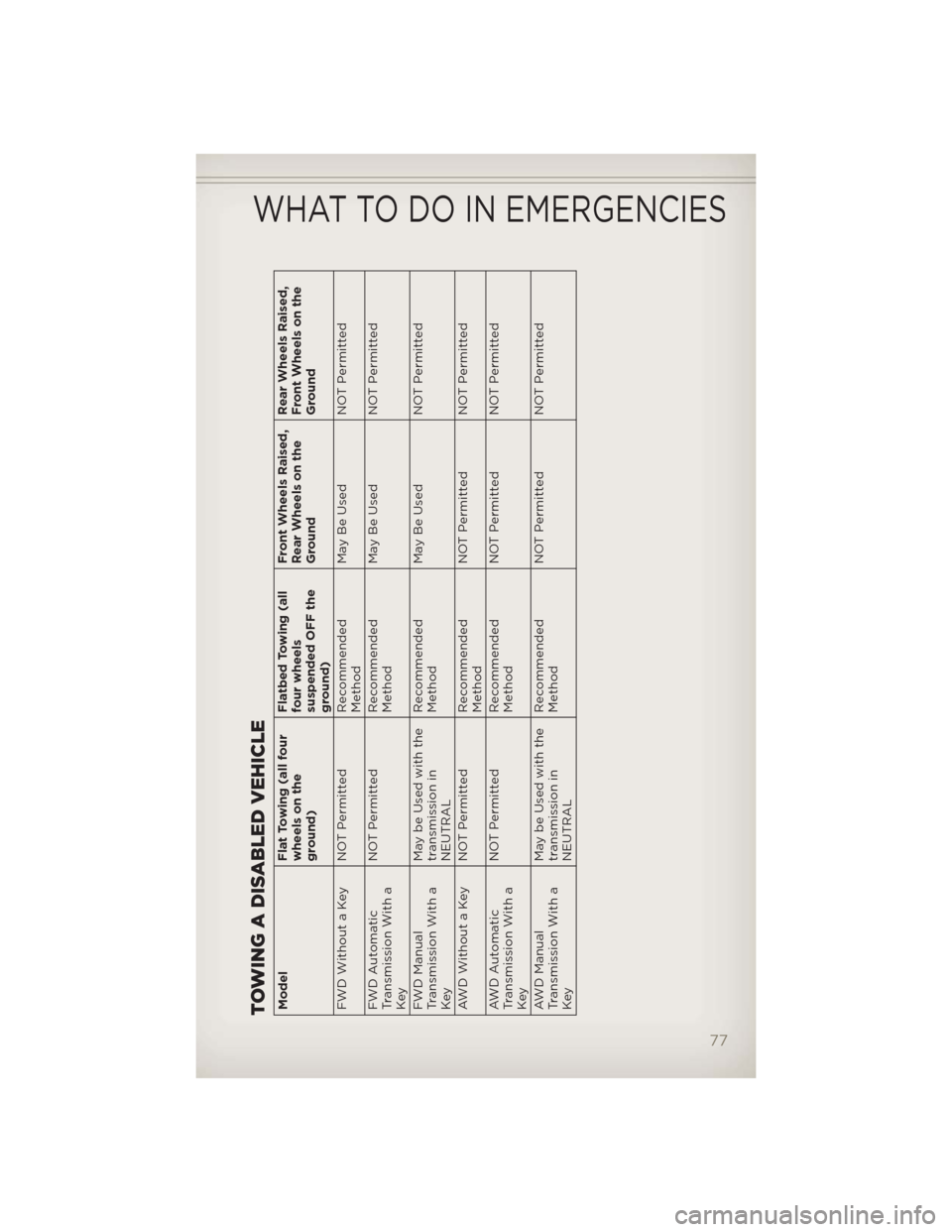
TOWING A DISABLED VEHICLEModelFlat Towing (all four
wheels on the
ground)Flatbed Towing (all
four wheels
suspended OFF the
ground)Front Wheels Raised,
Rear Wheels on the
GroundRear Wheels Raised,
Front Wheels on the
Ground
FWD Without a Key NOT Permitted Recommended
MethodMay Be Used NOT Permitted
FWD Automatic
Transmission With a
KeyNOT Permitted Recommended
MethodMay Be Used NOT Permitted
FWD Manual
Transmission With a
KeyMay be Used with the
transmission in
NEUTRALRecommended
MethodMay Be Used NOT Permitted
AWD Without a Key NOT Permitted Recommended
MethodNOT Permitted NOT Permitted
AWD Automatic
Transmission With a
KeyNOT Permitted Recommended
MethodNOT Permitted NOT Permitted
AWD Manual
Transmission With a
KeyMay be Used with the
transmission in
NEUTRALRecommended
MethodNOT Permitted NOT Permitted
WHAT TO DO IN EMERGENCIES
77
Page 86 of 108
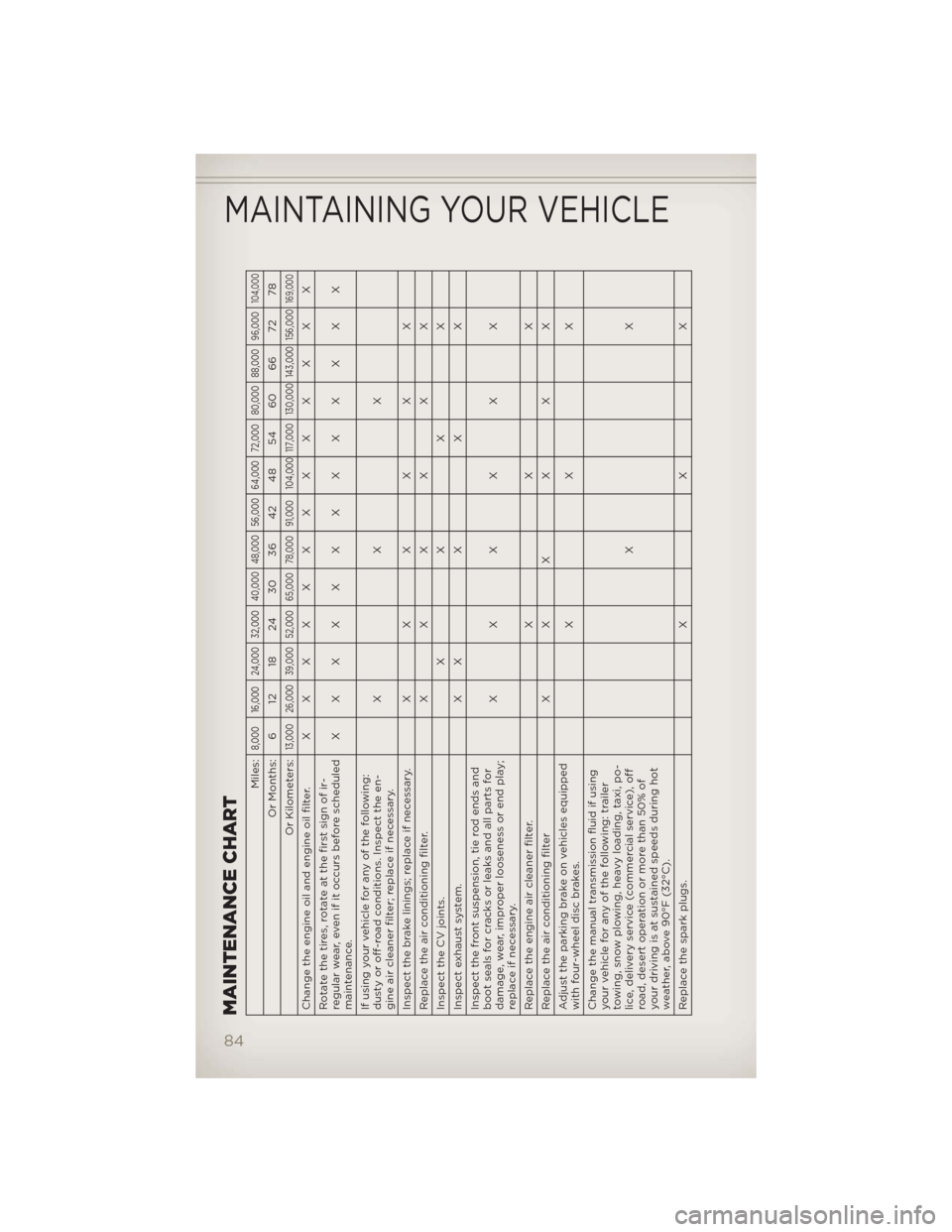
MAINTENANCE CHART
Miles:
8,000 16,000 24,000 32,000 40,000 48,000 56,000 64,000 72,000 80,000 88,000 96,000
104,000
Or Months: 6 12 18 24 30 36 42 48 54 60 66 72 78
Or Kilometers:
13,000 26,000 39,000 52,000 65,000 78,000 91,000 104,000 117,000 130,000 143,000 156,000
169,000
Change the engine oil and engine oil filter.XXXXXXXXXXXXX
Rotate the tires, rotate at the first sign of ir-
regular wear, even if it occurs before scheduled
maintenance.XXXXXXXXXXXXX
If using your vehicle for any of the following:
dusty or off-road conditions. Inspect the en-
gine air cleaner filter; replace if necessary.XXX
Inspect the brake linings; replace if necessary. X XXXXX
Replace the air conditioning filter. X XXXXX
InspecttheCVjoints. XXXX
Inspectexhaustsystem. XXXXX
Inspect the front suspension, tie rod ends and
boot seals for cracks or leaks and all parts for
damage, wear, improper looseness or end play;
replace if necessary.XXXXXX
Replace the engine air cleaner filter. X X X
Replace the air conditioning filter X X X X X X
Adjust the parking brake on vehicles equipped
with four-wheel disc brakes.XXX
Change the manual transmission fluid if using
your vehicle for any of the following: trailer
towing, snow plowing, heavy loading, taxi, po-
lice, delivery service (commercial service), off
road, desert operation or more than 50% of
your driving is at sustained speeds during hot
weather, above 90°F (32°C).XX
Replace the spark plugs. X X X
MAINTAINING YOUR VEHICLE
84